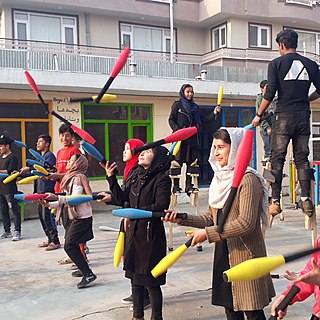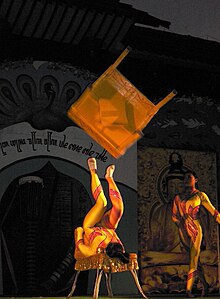
Juggling is a physical skill, performed by a juggler, involving the manipulation of objects for recreation, entertainment, art or sport. The most recognizable form of juggling is toss juggling. Juggling can be the manipulation of one object or many objects at the same time, most often using one or two hands but other body parts as well, like feet or head. Jugglers often refer to the objects they juggle as props. The most common props are balls, clubs, or rings. Some jugglers use more dramatic objects such as knives, fire torches or chainsaws. The term juggling can also commonly refer to other prop-based manipulation skills, such as diabolo, plate spinning, devil sticks, poi, cigar boxes, contact juggling, hooping, yo-yo, and hat manipulation.

In spoken language analysis, an utterance is a continuous piece of speech, by one person, before or after which there is silence on the part of the person. In the case of oral languages, it is generally, but not always, bounded by silence. Utterances do not exist in written language; only their representations do. They can be represented and delineated in written language in many ways.

Calisthenics or callisthenics (/ˌkælɪsˈθɛnɪks/) is a form of strength training that utilizes an individual's body weight as resistance to perform multi-joint, compound movements with little or no equipment.
Jāti is the term traditionally used to describe a cohesive group of people in the Indian subcontinent, like a tribe, community, clan, sub-clan, or a religious sect. Each Jāti typically has an association with an occupation, geography or tribe. Different intrareligious beliefs or linguistic groupings may also define some Jātis. The term is often translated approximately in English as caste.

Tightrope walking, also called funambulism, is the skill of walking along a thin wire or rope. It has a long tradition in various countries and is commonly associated with the circus. Other skills similar to tightrope walking include slack rope walking and slacklining.

Birchwood is a town and civil parish in the Borough of Warrington, Cheshire, England. The parish had a population of 10,614 at the 2021 census. Located originally in Lancashire, it was built as a new town in the 1970s. Birchwood is made up of three districts: Gorse Covert, Locking Stumps and Oakwood.

Stilts are poles, posts or pillars that allow a person or structure to stand at a height above the ground.
Antipode or Antipodes may refer to:
Juggling practice has developed a wide range of patterns and forms which involve different types of manipulation, different props, numbers of props, and numbers of jugglers. The forms of juggling shown here are practiced by amateur, non-performing, hobby jugglers as well as by professional jugglers. The variations of juggling shown here are extensive but not exhaustive as juggling practice develops and creates new patterns on a regular basis. Jugglers do not consciously isolate their juggling into one of the categories shown; instead most jugglers will practice two or more forms, combining the varieties of juggling practice. Some forms are commonly mixed, for example: numbers and patterns with balls; while others are rarely mixed, for example: contact numbers passing. Many Western jugglers also practice other forms of object manipulation, such as diabolo, devil sticks, cigar box manipulation, fire-spinning, contact juggling, hat manipulation, poi, staff-spinning, balancing tricks, bar flair and general circus skills.
Cross-dominance, also known as mixed-handedness, hand confusion, or mixed dominance, is a motor skill manifestation in which a person favors one hand for some tasks and the other hand for others, or a hand and the contralateral leg. For example, a cross-dominant person might write with the right hand and do everything else with the left one, or manage and kick a ball preferentially with the left leg.
Overall, being mixed handed seems to result in better performance than being strongly handed for sports such as basketball, ice hockey, and field hockey. What these sports have in common is that they require active body movements and also an ability to respond to either side. The situation is reversed for racquet sports such as tennis. Individuals with crossed hand-eye preference seem to be much better at gymnastics, running, and basketball because of the way in which congruent and crossed sided individuals position their bodies.

Adagio is the performance of partner acrobalance poses and associated movements that involve stationary balances by a pair of performers. It is performed in professional circus, in various dance disciplines including acro dance and ballet, in pair skating, and as a hobby in university circus groups.
The perch is an equilibristic balancing act where one performer balances atop a pole that is being balanced by another performer. Each perch pole has a loop at the top into which the performer may insert either a hand or a foot in order to perform a variety of tricks while hanging down from the loop. During the whole routine, the base at the bottom must balance the pole as the flier shifts their weight from one position to another, climbs up and down, and balances at the top.

A fireman's carry or fireman's lift is a technique allowing one person to carry another person without assistance, by placing the carried person across the shoulders of the carrier.

Prudence Risley Residential College for the Creative and Performing Arts, commonly known as Risley Residential College, Risley Hall, or just Risley, is a program house at Cornell University. Unlike most other dormitories on campus, Risley is a residential college; house members, or "Risleyites," have some say in the administration of the residence hall, can continue to reside there as long as they are enrolled at Cornell, are encouraged to eat together at the in-house dining hall, and participate in educational activities such as guest lectures within the dormitory.
This is a general glossary of the terms used in the sport of gymnastics.

Richard Risley Carlisle (1814–1874) was an American gymnast and acrobat who often performed as Professor Risley. He is known for developing a circus act of juggling with the feet known as the Risley act. An inveterate traveler to Europe, Australia and East Asia and serial entrepreneur, Risley also notably brought a Japanese circus act to America in the 1860s.
The civil liability of a recreational diver may include a duty of care to another diver during a dive. Breach of this duty that is a proximate cause of injury or loss to the other diver may lead to civil litigation for damages in compensation for the injury or loss suffered.
The term 30-million-word gap was originally coined by Betty Hart and Todd R. Risley in their book Meaningful Differences in the Everyday Experience of Young American Children, and subsequently reprinted in the article "The Early Catastrophe: The 30 Million Word Gap by Age 3". In their study of 42 Midwestern families, Hart and Risley physically recorded an hour's worth of language in each home once a month over 2½ years. Families were classified by socioeconomic status (SES) into "high" (professional), "middle/low" and "welfare" SES. They found that the average child in a professional family hears 2,153 words per waking hour, the average child in a working-class family hears 1,251 words per hour, and an average child in a welfare family only 616 words per hour. Extrapolating, they stated that, "in four years, an average child in a professional family would accumulate experience with almost 45 million words, an average child in a working-class family 26 million words, and an average child in a welfare family 13 million words."










